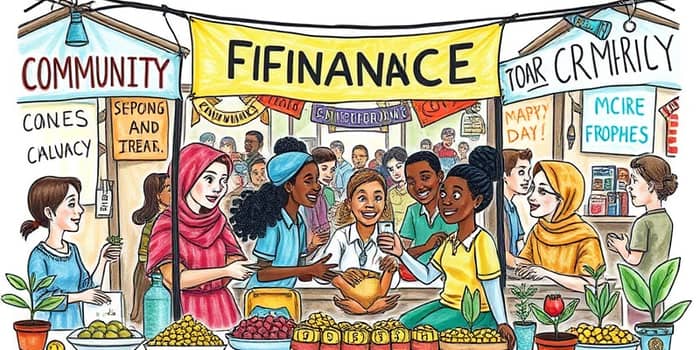Microloans have emerged as a beacon of hope for millions of aspiring entrepreneurs and underserved communities worldwide. By providing access to modest capital, these loans fuel creativity, drive innovation, and nurture local economies.
In this article, we explore how microloans operate, their profound social impact, and the transformative power they hold for individuals who have been overlooked by traditional banking systems.
Understanding Microloans and Their Core Concept
At their essence, microloans are small-dollar loans typically ranging from $500 to $50,000 that enable entrepreneurs to launch or grow ventures without the stringent credit requirements of conventional banks.
These funds are often extended by nonprofit organizations, government-sponsored programs, community-based microlenders, and innovative fintech platforms. Borrowers benefit from startups, low-income individuals, and rural entrepreneurs accessing vital resources despite limited or no collateral.
Repayment schedules are designed to be manageable, with terms spanning a few months up to seven years in some programs. This flexibility acknowledges the reality of fledgling businesses, allowing them to establish revenue streams before meeting their repayment obligations.
Growth and Market Dynamics
The global microlending market is valued at approximately $212–$233 billion in 2025 and is projected to soar beyond $541 billion by 2034, at a CAGR of around 9.8%.
This meteoric rise is fueled by rapid advancements in digital banking, mobile payment platforms, and financial inclusion initiatives driving global growth. Governments in regions such as Asia Pacific, particularly China and India, have championed policies that promote financial access for rural populations.
As of 2018, roughly 139.9 million borrowers had benefited from microloans, a significant increase from 98 million in 2009. This expansion underscores the enduring demand for accessible capital and the role of microloans in bridging funding gaps.
Who Benefits from Microloans?
Microloans serve a diverse demographic, with a pronounced focus on women and rural residents. Key statistics highlight:
- 80% of borrowers are women, empowering female-led enterprises
- 65% hail from rural areas, where traditional banking is scarce
- Many have limited credit history, yet possess strong business potential
This targeted support has fostered entrepreneurship in communities previously sidelined by mainstream finance, unlocking opportunities for economic growth and social progress.
Comparing Microloans and Traditional Loans
Understanding the distinctions between microloans and conventional credit is essential for prospective borrowers. The table below highlights the core differences:
Key Uses and Terms
Microloans are versatile, addressing a range of needs for small-scale operators. Typical applications include:
- Launching or expanding local businesses
- Covering daily operating expenses
- Purchasing inventory, equipment, or supplies
- Bridging short-term cash flow gaps
- Funding niche initiatives like childcare or veteran-owned enterprises
Repayment terms usually span 3–6 years, though some programs extend to seven years. Interest rates vary based on borrower profile, often landing in the high single to mid-double digit range.
Microloans as a Catalyst for Financial Inclusion
Today, over 2 billion individuals worldwide lack access to basic financial services. In many developing regions, fewer than 20% of aspiring entrepreneurs can secure traditional bank loans.
Microfinance institutions have filled this void, offering not only capital but also hope. Borrowers gain a chance to build sustainable businesses, improve household incomes, and generate employment in their communities.
Holistic Support and Beyond Lending
Modern microlenders recognize that capital alone is not enough. Many provide holistic support through training and counseling, covering topics such as financial management, marketing strategies, and operational planning.
These value-added services foster resilience and promote long-term success, creating a transformative effect beyond mere financial capital and solidifying the role of microloans as a comprehensive development tool.
Risks, Efficiency, and Sustainability
While demand for microloans has soared, lenders face rising operational costs. Between 2009 and 2018, the average cost per borrower climbed from $68.4 to $106.7. Despite this, many institutions have improved efficiency through digital platforms and streamlined processes.
Portfolio-at-risk (PAR) metrics have remained relatively stable, with PAR >30 days inching from 6.4% in 2009 to 7% by 2018. Improved return on assets and equity signals stronger financial health for leading microfinance organizations.
Real-World Impact and Regional Trends
Stories of success abound. Enterprises like Salt and Savour leveraged microloans via online platforms to acquire equipment, ramp up production, and create local jobs. Boutiques, bakeries, and landscaping services worldwide have similarly thrived.
Regionally, Asia Pacific dominates the market, driven by large rural populations in China and India. North America ranks second, with a growing emphasis on urban startups and businesses led by minorities.
As the microlending landscape evolves, continued innovation—particularly through fintech—promises to expand reach and reduce costs. The essence of microloans remains the same: empowering individuals to pursue their ambitions and uplift entire communities.
By combining accessible capital with strategic support, microfinance continues to transform lives, one small loan at a time. Entrepreneurs are no longer bound by barriers; they are propelled by opportunity, armed with the resources to build brighter futures.
References
- https://www.nav.com/blog/69-understanding-the-basics-microloans-vs-traditional-loans-5393/
- https://www.archivemarketresearch.com/reports/microloans-53113
- https://www.ltfinance.com/blog/what-is-micro-loan
- https://www.precedenceresearch.com/micro-lending-market
- https://www.sofi.com/learn/content/microloans/
- https://scoop.market.us/microfinance-statistics/
- https://www.credibly.com/guides/microloans/
- https://nextbillion.net/quiet-revival-of-microfinance-sector-poised-greater-growth-impact-2025-and-beyond/










